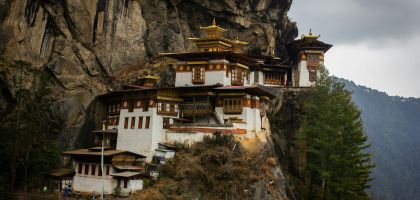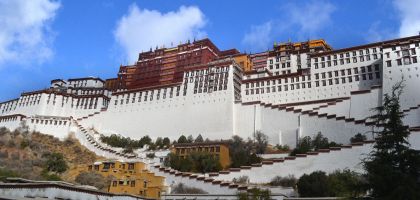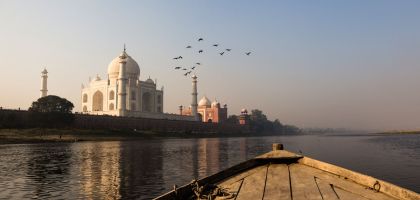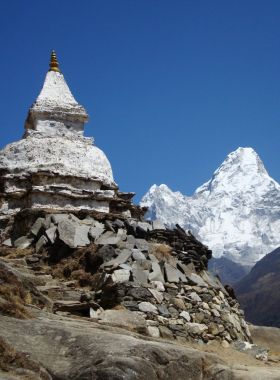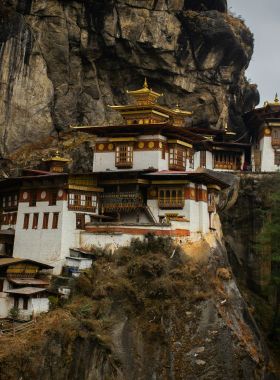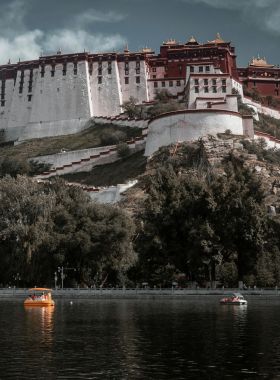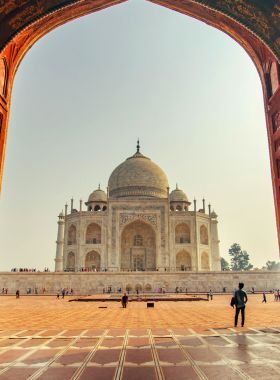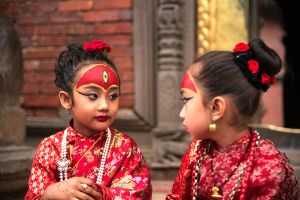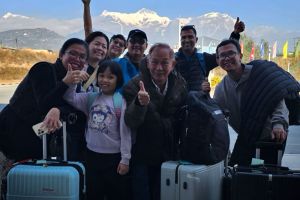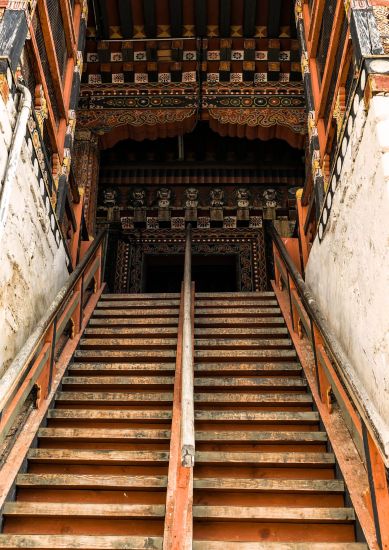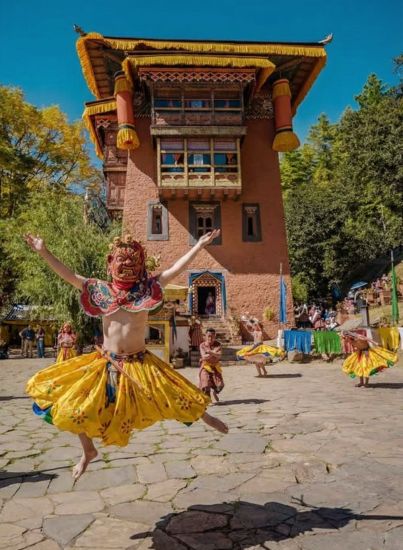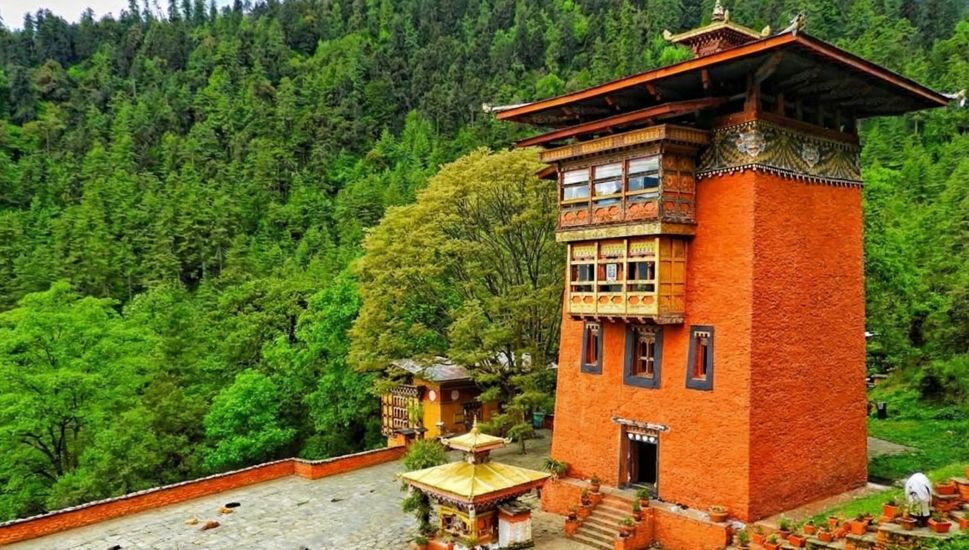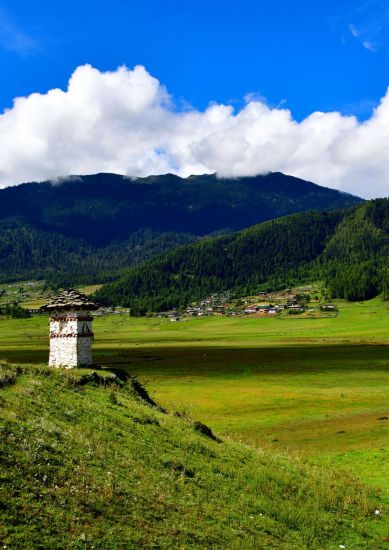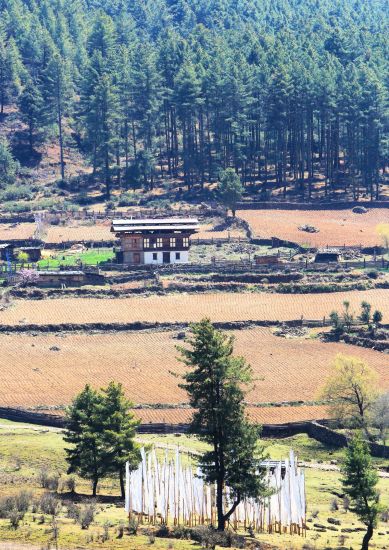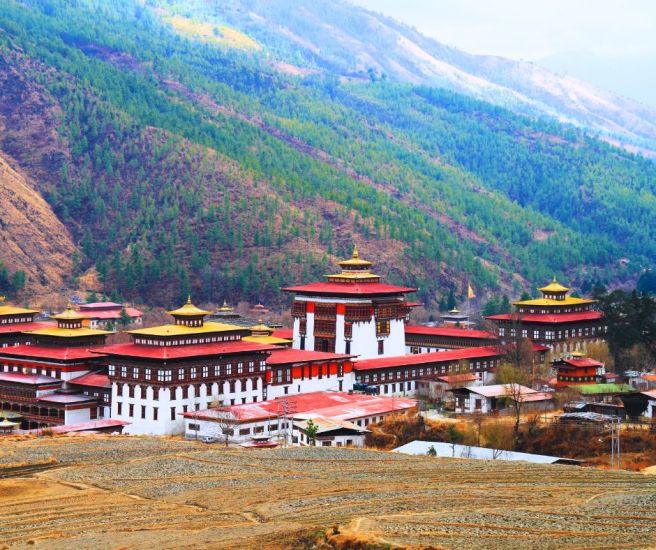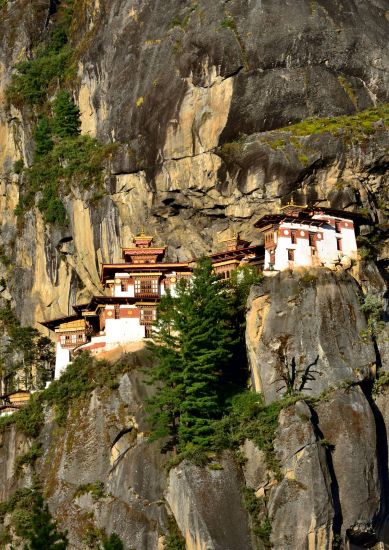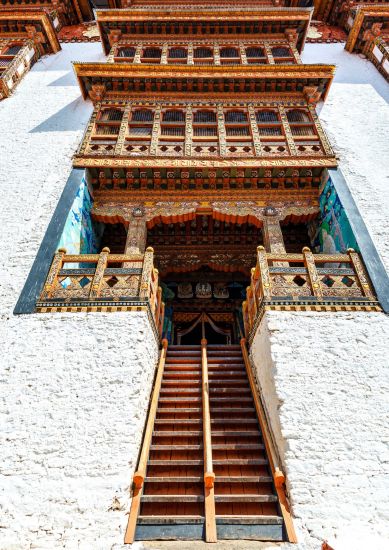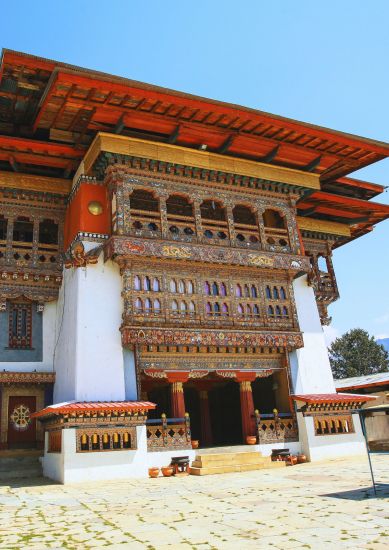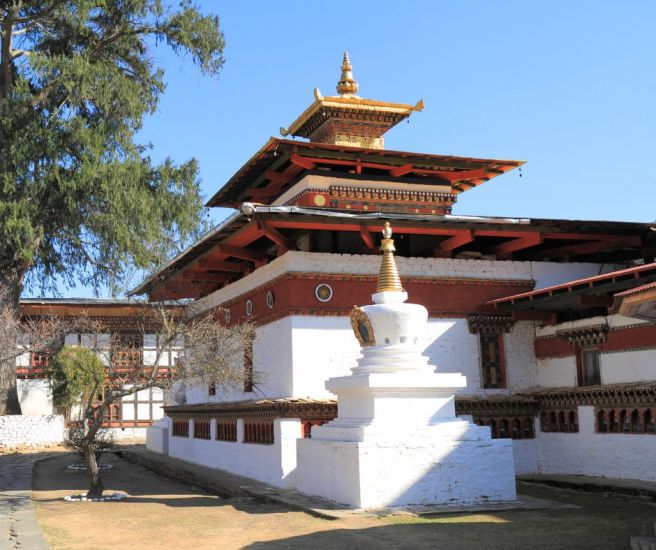Dechenphu Festival Tour
8 Days / Bhutan
Activity
Difficulty Level
Destinations
Trip Start / End
Accommodation
Travel Style
Best time to travel
Personalized Travel Advice

Dev Raj Nepal
+977 9851096523
Personalized Travel Advice

Dev Raj Nepal
+977 9851096523
Detailed Itinerary
01
DAY
01
Arrive in Paro, one of the most scenic airports in the world. After clearing immigration and visa formalities, you’ll be welcomed by your local Bhutanese guide. Begin your journey with a beautiful drive to Thimphu, Bhutan’s charming capital nestled in a broad valley.
En route, stop at Tachogang Lhakhang, a 15th-century temple built by the legendary Thangtong Gyalpo, famed as the Iron Bridge Builder. This temple, meaning “temple of the hill of the excellent horse,” was established following a divine vision and serves as an important spiritual and cultural site. Adjacent to the temple is the traditional iron chain suspension bridge across the Paro River, a pioneering engineering feat of its time and restored to preserve its legacy. Walking across this bridge offers a firsthand experience of Bhutan’s unique architectural heritage and spiritual history.
Settle into your hotel in Thimphu and enjoy the rest of the evening at leisure.
Arrival Paro – Drive to Thimphu
Arrive in Paro, one of the most scenic airports in the world. After clearing immigration and visa formalities, you’ll be welcomed by your local Bhutanese guide. Begin your journey with a beautiful drive to Thimphu, Bhutan’s charming capital nestled in a broad valley.
En route, stop at Tachogang Lhakhang, a 15th-century temple built by the legendary Thangtong Gyalpo, famed as the Iron Bridge Builder. This temple, meaning “temple of the hill of the excellent horse,” was established following a divine vision and serves as an important spiritual and cultural site. Adjacent to the temple is the traditional iron chain suspension bridge across the Paro River, a pioneering engineering feat of its time and restored to preserve its legacy. Walking across this bridge offers a firsthand experience of Bhutan’s unique architectural heritage and spiritual history.
Settle into your hotel in Thimphu and enjoy the rest of the evening at leisure.
02
DAY
02
Today, we attend the Dechenphu Tshechu Festival at Dechenphu Lhakhang, one of the most sacred temples in the city. Dechenphu Lhakhang is believed to be the residence of Geynyen Jagpa Melen, the guardian deity of Thimphu, making it a deeply revered spiritual site.
The Dechenphu Tshechu Festival is a vibrant celebration of Bhutanese spirituality and community life. It features a series of sacred mask dances and elaborate rituals that honor the city’s guardian deities. Visitors are treated to mesmerizing performances such as Zhananga Cham, Genyen Kunchaam, Shazam Cham, and Nga Cham, accompanied by traditional music that resonates through the temple grounds.
The festival atmosphere is both festive and solemn, with locals dressed in colorful traditional attire and participants performing intricate dances with symbolic masks. Every movement and chant carries centuries of cultural and religious significance, offering a rare and immersive insight into Bhutan’s Vajrayana Buddhist heritage.
Attending the Dechenphu Tshechu Festival is more than a visual spectacle—it is an invitation to experience Bhutanese devotion, community, and cultural pride up close, leaving visitors with a profound appreciation of the spiritual heartbeat of Thimphu.
Attend Dechenphu Festival
Today, we attend the Dechenphu Tshechu Festival at Dechenphu Lhakhang, one of the most sacred temples in the city. Dechenphu Lhakhang is believed to be the residence of Geynyen Jagpa Melen, the guardian deity of Thimphu, making it a deeply revered spiritual site.
The Dechenphu Tshechu Festival is a vibrant celebration of Bhutanese spirituality and community life. It features a series of sacred mask dances and elaborate rituals that honor the city’s guardian deities. Visitors are treated to mesmerizing performances such as Zhananga Cham, Genyen Kunchaam, Shazam Cham, and Nga Cham, accompanied by traditional music that resonates through the temple grounds.
The festival atmosphere is both festive and solemn, with locals dressed in colorful traditional attire and participants performing intricate dances with symbolic masks. Every movement and chant carries centuries of cultural and religious significance, offering a rare and immersive insight into Bhutan’s Vajrayana Buddhist heritage.
Attending the Dechenphu Tshechu Festival is more than a visual spectacle—it is an invitation to experience Bhutanese devotion, community, and cultural pride up close, leaving visitors with a profound appreciation of the spiritual heartbeat of Thimphu.
03
DAY
03
Begin your day exploring Thimphu, the vibrant capital of Bhutan, where tradition and modernity exist in perfect harmony. Start at the National Memorial Chorten, an iconic white stupa crowned with a golden spire, built in memory of the Third King, Jigme Dorji Wangchuck. Dedicated to world peace, this spiritual landmark is a place where locals gather to circumambulate in prayer, surrounded by exquisite Buddhist architecture, intricate paintings, and sculptures symbolizing the “Mind of Buddha.”
Continue to Buddha Point, home to the towering Buddha Dordenma Statue, one of the largest in the world, gazing peacefully over the Thimphu valley as a symbol of happiness and serenity. Next, visit Changangkha Lhakhang, a 12th-century fortress-like temple perched on a ridge, revered for blessings, especially for newborns, and offering sweeping views of the city. Proceed to the Motithang Takin Preserve to meet Bhutan’s national animal, the Takin, an endearing creature with the features of both a goat and a cow.
Enjoy a traditional Bhutanese lunch at a local restaurant before heading to the National Institute for Zorig Chusum, also known as the School of 13 Traditional Arts and Crafts. Established in 1971, this unique institute is dedicated to preserving Bhutan’s traditional arts such as painting, sculpting, wood carving, paper making, masonry, weaving, embroidery, and more.
Following this, visit the Textile Museum, where you will discover Bhutan’s vibrant textile traditions, renowned for their intricate patterns and vibrant colors. The museum exhibits traditional weaving techniques and showcases garments that highlight Bhutanese identity and craftsmanship, offering an exceptional appreciation of this living art form.
End your day at the magnificent Tashichho Dzong, a grand fortress and monastery that serves as the seat of Bhutan’s government and the summer residence of the Chief Abbot. With its whitewashed walls, gilded roofs, and intricate woodwork, the dzong stands as a masterpiece of Bhutanese architecture and a venue for the vibrant Thimphu Tshechu festival. This full-day journey weaves together spirituality, culture, wildlife, and history, offering a truly immersive introduction to Bhutan’s capital.
Thimphu Exploration
Begin your day exploring Thimphu, the vibrant capital of Bhutan, where tradition and modernity exist in perfect harmony. Start at the National Memorial Chorten, an iconic white stupa crowned with a golden spire, built in memory of the Third King, Jigme Dorji Wangchuck. Dedicated to world peace, this spiritual landmark is a place where locals gather to circumambulate in prayer, surrounded by exquisite Buddhist architecture, intricate paintings, and sculptures symbolizing the “Mind of Buddha.”
Continue to Buddha Point, home to the towering Buddha Dordenma Statue, one of the largest in the world, gazing peacefully over the Thimphu valley as a symbol of happiness and serenity. Next, visit Changangkha Lhakhang, a 12th-century fortress-like temple perched on a ridge, revered for blessings, especially for newborns, and offering sweeping views of the city. Proceed to the Motithang Takin Preserve to meet Bhutan’s national animal, the Takin, an endearing creature with the features of both a goat and a cow.
Enjoy a traditional Bhutanese lunch at a local restaurant before heading to the National Institute for Zorig Chusum, also known as the School of 13 Traditional Arts and Crafts. Established in 1971, this unique institute is dedicated to preserving Bhutan’s traditional arts such as painting, sculpting, wood carving, paper making, masonry, weaving, embroidery, and more.
Following this, visit the Textile Museum, where you will discover Bhutan’s vibrant textile traditions, renowned for their intricate patterns and vibrant colors. The museum exhibits traditional weaving techniques and showcases garments that highlight Bhutanese identity and craftsmanship, offering an exceptional appreciation of this living art form.
End your day at the magnificent Tashichho Dzong, a grand fortress and monastery that serves as the seat of Bhutan’s government and the summer residence of the Chief Abbot. With its whitewashed walls, gilded roofs, and intricate woodwork, the dzong stands as a masterpiece of Bhutanese architecture and a venue for the vibrant Thimphu Tshechu festival. This full-day journey weaves together spirituality, culture, wildlife, and history, offering a truly immersive introduction to Bhutan’s capital.
04
DAY
04
In the morning, take a scenic drive from Thimphu to Phobjikha. This journey leads you across beautiful landscapes of Bhutan, including forested valleys and mountainous terrain, gradually approaching the Phobjikha Valley. Known for its serene environment, the valley is famous as a winter home to the rare black-necked cranes.
Exploration in the Gangtey village region begins with a visit to the historic and architecturally elegant Gangtey Goempa (Monastery). This visit allows you to appreciate the monastery’s spiritual significance and beautiful setting while fresh and attentive.
Next, proceed to the Black Necked Crane Information Centre nearby. The center provides valuable insights into the conservation of these endangered birds and offers mounted binoculars for observing the cranes in their natural marshland habitat, especially during their winter months from late October to mid-February. This day offers a harmonious blend of nature, culture, and wildlife.
Thimphu-Phobjikha
In the morning, take a scenic drive from Thimphu to Phobjikha. This journey leads you across beautiful landscapes of Bhutan, including forested valleys and mountainous terrain, gradually approaching the Phobjikha Valley. Known for its serene environment, the valley is famous as a winter home to the rare black-necked cranes.
Exploration in the Gangtey village region begins with a visit to the historic and architecturally elegant Gangtey Goempa (Monastery). This visit allows you to appreciate the monastery’s spiritual significance and beautiful setting while fresh and attentive.
Next, proceed to the Black Necked Crane Information Centre nearby. The center provides valuable insights into the conservation of these endangered birds and offers mounted binoculars for observing the cranes in their natural marshland habitat, especially during their winter months from late October to mid-February. This day offers a harmonious blend of nature, culture, and wildlife.
05
DAY
05
Start your day with a scenic drive from Phobjikha Valley to Punakha, which covers approximately 78 kilometers and typically takes around 3 hours by road. The journey takes you through varied landscapes of forested valleys, mountain ridges, and winding roads, offering spectacular views of Bhutan’s natural beauty along the way.
Upon arrival in Punakha, begin your exploration with a visit to the Chimi Lhakhang, also known as the Fertility Temple. This small but spiritually significant temple was built in the 15th century by Lama Drukpa Kunley, famously known as the “Divine Madman,” who is celebrated for his unconventional and humorous approach to spreading Buddhism. Chimi Lhakhang is a popular pilgrimage site for couples seeking blessings for fertility and happy marital life. The temple is nestled amid rice fields and is accessible by a pleasant short walk, adding to its serene and pastoral charm.
Continue to the majestic Punakha Dzong, an architectural masterpiece dramatically set at the confluence of the Pho Chhu and Mo Chhu rivers. Often called the “Palace of Great Happiness,” this grand fortress-monastery served as Bhutan’s capital until the mid-20th century and remains an important seat of governance and religion. With its towering whitewashed walls, gilded spires, and intricately carved woodwork, Punakha Dzong is a striking testament to Bhutanese craftsmanship and history, making it one of the country’s most revered and photographed landmarks.
Phobjikha – Punakha
Start your day with a scenic drive from Phobjikha Valley to Punakha, which covers approximately 78 kilometers and typically takes around 3 hours by road. The journey takes you through varied landscapes of forested valleys, mountain ridges, and winding roads, offering spectacular views of Bhutan’s natural beauty along the way.
Upon arrival in Punakha, begin your exploration with a visit to the Chimi Lhakhang, also known as the Fertility Temple. This small but spiritually significant temple was built in the 15th century by Lama Drukpa Kunley, famously known as the “Divine Madman,” who is celebrated for his unconventional and humorous approach to spreading Buddhism. Chimi Lhakhang is a popular pilgrimage site for couples seeking blessings for fertility and happy marital life. The temple is nestled amid rice fields and is accessible by a pleasant short walk, adding to its serene and pastoral charm.
Continue to the majestic Punakha Dzong, an architectural masterpiece dramatically set at the confluence of the Pho Chhu and Mo Chhu rivers. Often called the “Palace of Great Happiness,” this grand fortress-monastery served as Bhutan’s capital until the mid-20th century and remains an important seat of governance and religion. With its towering whitewashed walls, gilded spires, and intricately carved woodwork, Punakha Dzong is a striking testament to Bhutanese craftsmanship and history, making it one of the country’s most revered and photographed landmarks.
06
DAY
06
This day begins with a morning drive from Punakha to Paro, a journey of about 3 to 4 hours through scenic mountainous landscapes, including a crossing of the Dochula Pass, which offers stunning views of the eastern Himalayas. Take a short break here to enjoy the 360-degree panorama and the sight of the 108 memorial chortens that grace the pass. The route continues through forested valleys and winding mountain ridges before descending into the serene Paro Valley.
Upon arrival in Paro, visit the impressive Rinpung Dzong, a majestic fortress-monastery that is a fine example of Bhutanese architecture and cultural heritage. Rinpung Dzong serves as both an administrative and monastic center and is known for its intricate woodwork, whitewashed walls, and beautiful courtyards. The dzong overlooks the Paro Valley and holds historical and religious significance, making it a key highlight of your visit to Paro. You can walk to Rinpung Dzong after lunch. It is slightly uphill but the views are magnificent. After visiting the Dzong, your vehicle will drive you back to your hotel
Punakha to Paro
This day begins with a morning drive from Punakha to Paro, a journey of about 3 to 4 hours through scenic mountainous landscapes, including a crossing of the Dochula Pass, which offers stunning views of the eastern Himalayas. Take a short break here to enjoy the 360-degree panorama and the sight of the 108 memorial chortens that grace the pass. The route continues through forested valleys and winding mountain ridges before descending into the serene Paro Valley.
Upon arrival in Paro, visit the impressive Rinpung Dzong, a majestic fortress-monastery that is a fine example of Bhutanese architecture and cultural heritage. Rinpung Dzong serves as both an administrative and monastic center and is known for its intricate woodwork, whitewashed walls, and beautiful courtyards. The dzong overlooks the Paro Valley and holds historical and religious significance, making it a key highlight of your visit to Paro. You can walk to Rinpung Dzong after lunch. It is slightly uphill but the views are magnificent. After visiting the Dzong, your vehicle will drive you back to your hotel
07
DAY
07
Today is the highlight of your Bhutan journey, a memorable hike to the iconic Taktsang Monastery, famously known as the Tiger’s Nest. After an early breakfast, we drive a short distance to the trailhead and begin our hike.
Perched dramatically on a sheer cliff face at 3,120 meters (10,240 feet) above sea level, Tiger’s Nest is one of the most sacred sites in Bhutan. It is believed that Guru Rinpoche (Padmasambhava) flew here on the back of a tigress in the 8th century to subdue a local demon, meditating in the caves for three months. The monastery complex, built around those caves, clings impossibly to the cliffs and is both spiritually profound and visually awe-inspiring.
The hike takes around 4 to 5 hours’ round trip, with an option to rest midway at a viewpoint café, offering a perfect vantage point for photos and a cup of tea. For those who prefer not to walk the entire distance, ponies are available up to the halfway point.
Once at the top, you’ll have time to explore the monastery’s inner sanctums, listen to the wind flutter through the prayer flags, and absorb the peaceful energy of this mystical site.
After descending and returning to Paro, the rest of the afternoon and evening is free for you to relax or explore the town at your own pace. It’s a perfect opportunity to reflect on your journey and perhaps pick up a few Bhutanese souvenirs. Overnight in Paro.
Paro-Hike to Tiger’s Nest
Today is the highlight of your Bhutan journey, a memorable hike to the iconic Taktsang Monastery, famously known as the Tiger’s Nest. After an early breakfast, we drive a short distance to the trailhead and begin our hike.
Perched dramatically on a sheer cliff face at 3,120 meters (10,240 feet) above sea level, Tiger’s Nest is one of the most sacred sites in Bhutan. It is believed that Guru Rinpoche (Padmasambhava) flew here on the back of a tigress in the 8th century to subdue a local demon, meditating in the caves for three months. The monastery complex, built around those caves, clings impossibly to the cliffs and is both spiritually profound and visually awe-inspiring.
The hike takes around 4 to 5 hours’ round trip, with an option to rest midway at a viewpoint café, offering a perfect vantage point for photos and a cup of tea. For those who prefer not to walk the entire distance, ponies are available up to the halfway point.
Once at the top, you’ll have time to explore the monastery’s inner sanctums, listen to the wind flutter through the prayer flags, and absorb the peaceful energy of this mystical site.
After descending and returning to Paro, the rest of the afternoon and evening is free for you to relax or explore the town at your own pace. It’s a perfect opportunity to reflect on your journey and perhaps pick up a few Bhutanese souvenirs. Overnight in Paro.
08
DAY
08
After breakfast, it’s time to bid farewell to the enchanting kingdom of Bhutan. Take with you the memories of serene valleys, vibrant festivals, warm smiles, and timeless traditions that have made your journey unforgettable. Our team will escort you to Paro International Airport for your onward flight, wishing you safe travels and hoping to welcome you back again to explore more of Bhutan’s magic.
Paro- Departure
After breakfast, it’s time to bid farewell to the enchanting kingdom of Bhutan. Take with you the memories of serene valleys, vibrant festivals, warm smiles, and timeless traditions that have made your journey unforgettable. Our team will escort you to Paro International Airport for your onward flight, wishing you safe travels and hoping to welcome you back again to explore more of Bhutan’s magic.
Tour Cost
At High Asia Tours, we know that understanding tour costs is essential for planning your trip. Due to variables such as accommodation choices, meal plans, transportation options, group size, and seasonal demand, providing an exact price upfront is challenging.
To assist you, we offer a starting price to give a general idea of the cost:
The starting cost for this tour is
Includes / Excludes
Inclusions
-
Airport pick-up and drop-off by private transportation within Bhutan
-
Sightseeing and entrance fees as per the itinerary
-
Accommodation in hotels, usually on a twin/double sharing basis
-
All meals in Bhutan
-
Experience English Speaking Guide
-
Bhutan Visa Fee
-
All necessary travel permits
-
Local transportation for all drives mentioned in the itinerary
-
Festival participation (e.g., Dechenphu Tshechu entry and related activities)
Exclusions
-
Travel insurance and medical expenses
-
Optional activities or excursions not mentioned in the itinerary
-
Personal expenses such as beverages (alcoholic or non-alcoholic), tips for guides and drivers, laundry, phone calls, etc.
-
Additional costs due to unforeseen events (flight cancellations, weather delays, natural calamities)
-
Any optional activities not mentioned
Trip Info
In the Dzongkha (Bhutan’s National Language) or Tibetan languages, Lhakhang means Temple. Dechenphug Lhakhang is an important and ancient monastery on the western slope of the Thimphu valley. It stands in a quiet forested area and has been a place of worship since the 12th century.
The temple was founded by Dampa, a descendant of Phajo Drugom Shigpo, the master who introduced and spread the Drukpa school of Buddhism in Bhutan. Because of this lineage, Dechenphug is deeply connected to Bhutan’s spiritual history and to the guardian traditions that have protected the valley for centuries.
The main deity of the monastery is Geynyen, the fierce warrior protector of Thimphu valley. According to legend, he was subdued and established here as a guardian by the 14th-century master Kuenga Sengye, who strengthened the monastery’s spiritual role. Today, many Bhutanese visit Dechenphug to seek Geynyen’s blessings before starting important tasks, beginning new journeys, or praying for the health and protection of their family members.
A key feature of the monastery is its fortified goenkhang, a strong defensive tower built with thick stone walls and a single entrance. This tower houses sacred shrines, old murals, and a collection of weapons believed to have been taken during historic battles.
In front of the tower lies a revered stone known as the Thimphu stone, which is believed to be the resting place of Geynyen until he is called upon to protect the nation.
Dechenphug Lhakhang is also the site of the Dechenphu Tshechu, an important annual festival celebrated by the local community. The monastery continues to be a deeply sacred place for Bhutanese pilgrims, who visit daily to offer prayers.
In order to preserve its sanctity, the inner parts of the temple remain closed to foreign tourists, keeping its spiritual environment reserved for Bhutanese worshippers.
Dechenphu Festival Tour
The Dechenphu Tshechu unfolds each year at Dechenphu Lhakhang, nestled in the northern reaches of Thimphu valley near Dechencholing. This sacred festival honors Gay Ngyen Jakpa Melen, a revered guardian deity of Bhutan, drawing both locals and visitors into a vibrant celebration of tradition and devotion. The event offers a rare opportunity for foreign tourists to experience the spiritual heart of the Dechenphu temple, a privilege granted only on this special day. Introduced in 2003 under the guidance of His Majesty the Fourth King, the festival weaves ancient Buddhist symbolism with a proud expression of Bhutan’s living culture.
Throughout this Bhutan festival tour, sacred dances fill the air with energy and meaning. Performances such as the Zhananga Cham, Genyen Kunchaam, Shazam Cham, and Nga Cham come alive with the powerful rhythm of horns and cymbals. These dances vividly bring Buddhist teachings and rituals to life, invoking blessings and protection for the community. Beyond the captivating ceremonies, the festival cultivates a profound spirit of unity, peace, and joy, reflected in the radiant faces of those gathered. It opens a window into Bhutan’s Vajrayana Buddhist heritage, offering a deeply immersive celebration of faith, culture, and timeless tradition.
In late October, the weather across Thimphu, Paro, Punakha, and Gangtey is comfortably mild and well-suited for travel and outdoor adventures. Daytime temperatures typically hover between 15°C and 22°C (59°F to 72°F), with mornings and evenings bringing cooler air that calls for layered clothing. Higher elevations like Thimphu and Paro enjoy mostly clear skies, light rainfall averaging 40 to 70 mm, and crisp, fresh air, perfect conditions for stunning views of the Himalayan peaks.
Punakha, resting at a lower altitude, experiences warmer days reaching up to 26°C (79°F), paired with slightly higher humidity, yet it remains relatively dry compared to the monsoon season. The nights cool down pleasantly, offering a comfortable contrast. Gangtey and the Phobjikha Valley share similar mild weather, with clear skies that invite peaceful nature walks and valley explorations.
Overall, late October brings a steady, cool climate with clear conditions across these iconic Bhutan destinations. It’s an ideal time to enjoy cultural festivals, scenic drives, hikes, and historic landmarks with little risk of weather disruptions.
Throughout your journey in Bhutan, you will stay in carefully selected boutique-style resorts and hotels that offer an intimate and personalized experience, blending traditional Bhutanese aesthetics with contemporary comforts. These accommodations are typically set in serene locations that complement the natural beauty of their surroundings.
Each property emphasizes warm hospitality, with elegantly designed rooms that showcase Bhutanese architectural and interior design elements such as rich woodwork, local textiles, and subtle cultural motifs. Guests can expect spacious, comfortable accommodations with modern amenities including private bathrooms, Wi-Fi connectivity, and wellness facilities such as spa services in selected locations. The atmosphere in these boutique lodgings provides a tranquil retreat after a day of exploration, allowing guests to relax and recharge while immersing themselves in Bhutan’s cultural ambiance.
Whether your stay is in a quaint mountain resort with panoramic valley views, a boutique retreat surrounded by nature, or an urban-style hotel with spa amenities, these carefully curated properties reflect Bhutan’s unique blend of tradition and modernity. They ensure an authentic yet comfortable experience that harmonizes with the spiritual and natural journey of your trip.
For your journey, we’ll be traveling in a comfortable SUV equipped with air conditioning, ensuring a pleasant and cool ride as you explore Bhutan’s stunning landscapes. The SUV is selected for its reliability, spaciousness, and ability to handle Bhutan’s scenic yet sometimes challenging terrain, offering both comfort and convenience throughout the journey. Accompanying you will be a professional and experienced driver, familiar with the roads and always focused on your safety and comfort. With a calm demeanor and a wealth of local knowledge, your driver will guide you through the winding roads, allowing you to relax and enjoy the ever-changing views of this Himalayan paradise.
Bhutanese cuisine, widely available in both restaurants and hotels, centers around rice as a staple, accompanied by an assortment of flavorful side dishes. These typically include lentils, a variety of meats, and fresh vegetables, all prepared with unique Bhutanese spices that enhance their taste. Whether you prefer vegetarian meals or enjoy non-vegetarian dishes, Bhutan offers a diverse culinary experience to suit every palate.
For those looking to explore beyond the standard offerings, rural regions introduce a distinct aspect of Bhutanese food culture. Here, people commonly consume red rice and buckwheat-based dishes, adding a rustic and wholesome dimension to the dining experience. Trying these traditional staples not only offers a taste of Bhutan’s agrarian heritage but also an opportunity to appreciate the deep-rooted culinary traditions that make Bhutanese food truly special.
FAQs
Personalized Travel Advice

Dev Raj Nepal
+977 9851096523

